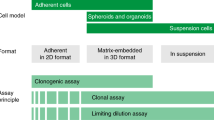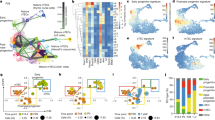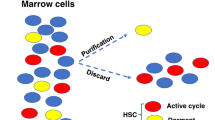Stem cell proliferative history in tissue revealed by temporal halogenated thymidine analog discrimination (original) (raw)
- Brief Communication
- Published: 17 February 2005
Nature Methods volume 2, pages 167–169 (2005)Cite this article
Abstract
Detection of proliferating cells based on bromodeoxyuridine (BrdU) incorporation and determination of phenotype by immunofluorescence labeling are standard approaches for studying stem and progenitor cell populations in developing and adult tissue as well as in histopathology studies. We describe incorporation of different halogenated thymidine analogs for temporal discrimination of cell cycle in the rat. With equimolar delivery, these analogs are suitable for quantitative histological studies including assessment of the regulation of proliferation, clonal analysis and simultaneous profiling of cell phenotype relative to proliferative history.
This is a preview of subscription content, access via your institution
Access options
Subscribe to this journal
Receive 12 print issues and online access
$259.00 per year
only $21.58 per issue
Buy this article
- Purchase on SpringerLink
- Instant access to full article PDF
Prices may be subject to local taxes which are calculated during checkout
Additional access options:
Similar content being viewed by others



The universal stem cell
Article Open access 28 October 2022
References
- Rakic, P. Science 183, 425–427 (1974).
Article CAS PubMed Google Scholar - Takahashi, T., Nowakowski, R.S. & Caviness, V.S., Jr. J. Neurocytol. 21, 185–197 (1992).
Article CAS PubMed Google Scholar - Eriksson, P.S. et al. Nat. Med. 4, 1313–1317 (1998).
Article CAS PubMed Google Scholar - Magavi, S.S., Leavitt, B.R. & Macklis, J.D. Nature 405, 951–955 (2000).
Article CAS PubMed Google Scholar - Braun, K.M. et al. Development 130, 5241–5255 (2003).
Article CAS PubMed Google Scholar - Aten, J.A. et al. Histochem. J. 24, 251–259 (1992).
Article CAS PubMed Google Scholar - Manders, E.E.M. et al. J. Cell Sci. 103, 857–862 (1992).
CAS PubMed Google Scholar - Ma, H. et al. J. Cell Biol. 143, 1415–1425 (1998).
Article CAS PubMed PubMed Central Google Scholar - Maslov, A.Y., Barone, T.A., Plunkett, R.J. & Pruitt, S.C. J. Neurosci. 24, 1726–1733 (2004).
Article CAS PubMed PubMed Central Google Scholar - Coskun, V. & Luskin, M.B. J. Neurosci. Res. 69, 795–802 (2002).
Article CAS PubMed PubMed Central Google Scholar - Peterson, D.A. Methods 18, 493–507 (1999).
Article CAS PubMed Google Scholar - Peterson, D.A. in Quantitative Methods in Neuroscience (eds. Evans, S.M., Janson, A.M. & Nyengaard, J.R.) 85–114 (Oxford Univ. Press, Oxford, 2004).
Book Google Scholar
Acknowledgements
This work was supported by National Institutes of Health AG20047.
Author information
Authors and Affiliations
- Department of Neuroscience, The Chicago Medical School at Rosalind Franklin University of Medicine and Science, 3333 Green Bay Road, North Chicago, 60064, Illinois, USA
Christopher J Vega & Daniel A Peterson
Authors
- Christopher J Vega
You can also search for this author inPubMed Google Scholar - Daniel A Peterson
You can also search for this author inPubMed Google Scholar
Corresponding author
Correspondence toDaniel A Peterson.
Ethics declarations
Competing interests
The authors declare no competing financial interests.
Supplementary information
Supplementary Fig. 1
Immunohistochemical detection can discriminate between CldU and IdU. (PDF 5294 kb)
Supplementary Fig. 2
Immunohistochemistry for CldU and IdU detects an equivalent population of proliferating cells, but only with equimolar delivery of the halogenated thymidine analogs. (PDF 4767 kb)
Supplementary Fig. 3
Temporal separation of CldU and IdU administration permits the determination of neural stem/progenitor cell proliferative history. (PDF 3317 kb)
Supplementary Methods (PDF 86 kb)
Rights and permissions
About this article
Cite this article
Vega, C., Peterson, D. Stem cell proliferative history in tissue revealed by temporal halogenated thymidine analog discrimination.Nat Methods 2, 167–169 (2005). https://doi.org/10.1038/nmeth741
- Received: 22 November 2004
- Accepted: 20 January 2005
- Published: 17 February 2005
- Issue Date: March 2005
- DOI: https://doi.org/10.1038/nmeth741